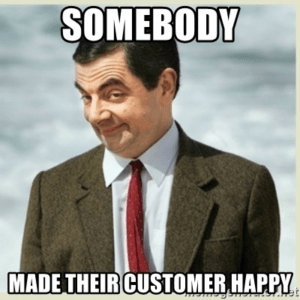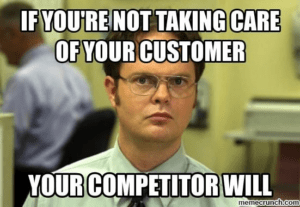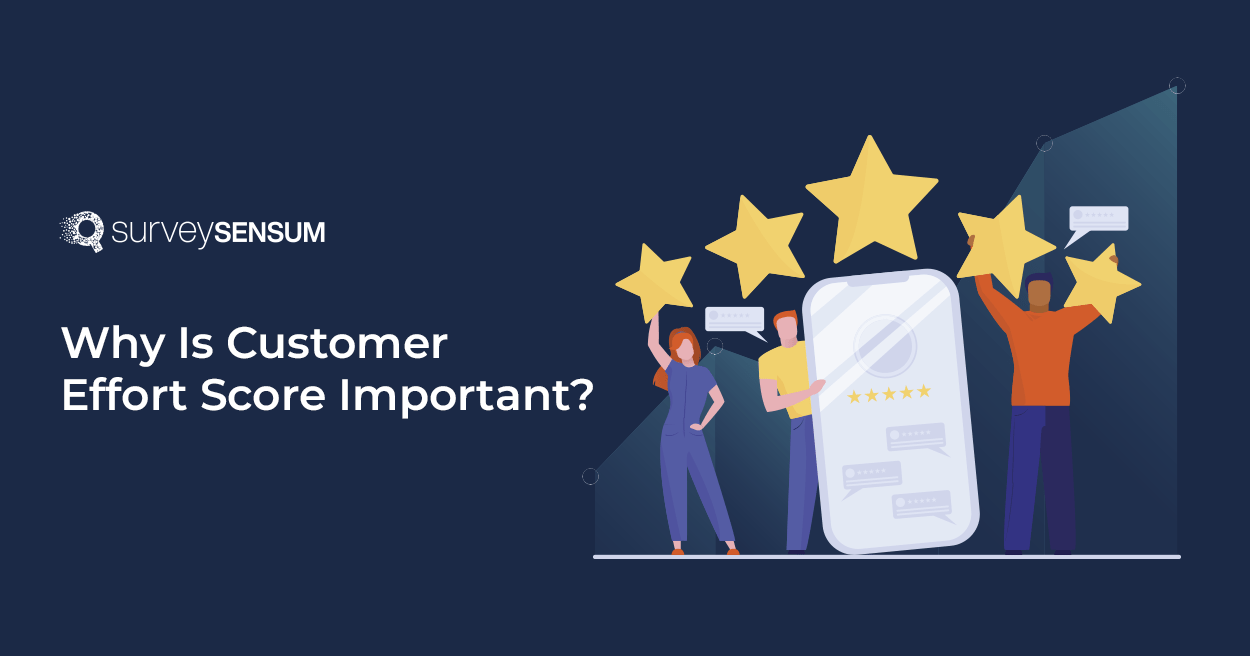
Think of some companies that you stopped doing business with because of their terrible customer service and the amount of effort it took on your part to do a simple task.
You probably have a dozen on your mind.
It can be multiple businesses- from a simple dry cleaning service that doesn’t understand the meaning of ‘rush order’ to a simple video subscription service whose customer service reps seem to be living under the rock.
According to PwC’s report, The Future of Customer Experience, 73% of customers stated that their experience with a company matters the most – so much that 59% of the customers reported that they will walk away from a brand after bad experiences and 17% after just one bad experience.
As a customer, it is natural to abandon a business if the experience is bad and sometimes even be resentful by leaving negative reviews online.
But this is a reality that many companies fail to understand.
So, what is the solution here?
— Simple, REDUCE EFFORT.
But how?
With an age-old customer experience metric called Customer Effort Score (CES).
What is it and how is it going to reduce obstacles and make the customer experience smooth like butter? Well, that’s what I am here to tell you.
Going Above and Beyond is Not the Key to Exceptional Customer Experience
Why Is Customer Effort Score Important?
Going Above and Beyond is Not the Key to Exceptional Customer Experience
To put it simply – businesses use customer effort score to figure out how much work their customers have to do when they’re dealing with their products or services.
Keeping the above definition in mind, do you think that if companies focus solely on going above and beyond in satisfying customers they will turn them into loyal customers easily?
No..
When companies analyze their customer journey they often use CSAT surveys to understand how satisfied their customers are. While this survey provides valuable insights, it solely focuses on a particular interaction like a customer service call or live chat and asks questions on a single aspect of the interaction like how knowledgeable or helpful the agent was.
Since these questions don’t specify if the customer faced any difficulties during the interaction, then how will the company be aware of any issues and solve them?
That’s where CES surveys come in.
By being aware of your CES, you can focus on assessing how much effort your customers make to accomplish their goals, resolve issues, or complete tasks related to their interaction with your company.
This will enable you to understand where your customers are facing obstacles, identify those friction points, and resolve them which will make your customer experience hassle-free – prompting a long-lasting relationship.
That’s why we need to Stop Delighting Our Customers and instead focus on Making Experiences Easy for Them.
Why Is Customer Effort Score Important?
Imagine this: You bought an AC recently, and although you were okay with waiting a couple of days for the free installation promised during purchase, things didn’t go smoothly. After three days with no communication, you had to call customer support. But the journey was far from easy – you got passed around different teams, and it took a frustrating six days of back-and-forth before someone finally installed the AC.
Naturally, you feel frustrated and might feel encouraged to quit the brand and also tell your friends and family about the experience, influencing their opinion of the brand.
Similarly, customers feel frustrated when their interaction with a company involves:
- Switching between multiple channels
- Re-explaining their problems to different agents
- Getting transferred between different departments or agents
- Repeatedly contacting the company for the same issue.
The more your customer have to put effort to engage with your company, the less happy they will be and the less likely they will become your loyal customer.
This is the reason why measuring customer effort score is an important factor that businesses need to take seriously. It will help in:
- addressing pain points which will enable businesses to reduce customer effort – minimizing customer dissatisfaction and churn.
- assessing the holistic experience across various touchpoints and interactions which will reflect the complexity of customer journeys.
- focusing on reducing customer effort which will allow businesses to align their services with customer expectations – enhancing the overall customer experience.
- delivering a low-effort customer experience that will set your business apart from your competitors.
7 Benefits of Measuring Customer Effort Score
Now that you have understood the importance of measuring customer effort score, let’s understand the top 7 benefits of measuring CES.
1. CES Predicts Customer Purchase Behavior

Sounds like a marketing gimmick, right? But it’s not.
According to the study conducted by Harvard Business Review on customer experience, 94% of customers reporting low effort said they would repurchase, while 88% said they would increase their spending.
There is a direct link between CES and customer purchase behavior. Positive experience or low effort on the customer side will motivate them to shop more and even become loyal customers of your business, whereas a high effort can reverse it.
As there is a direct correlation between customer effort and their purchasing behavior, don’t you think it is logical that you should focus on a low effort score?
Here’s how you can do that.
- Streamline Processes: Identify areas of high customer effort, such as complex checkout processes or lengthy support interactions. Streamline these processes to make them more efficient and user-friendly.
- Enhance Self-Service: Provide robust self-service options and resources to empower customers to find solutions on their own.
- Improve Support Channels: Offer multiple support channels, such as chat, email, and phone, to cater to different customer preferences. Ensure that response times are fast, and issues are resolved effectively.
- Customer feedback: Create CES surveys to actively seek feedback from customers regarding their experiences and any pain points they encounter.
- Close the feedback loop: Use the data from the feedback to identify areas of improvement and make iterative improvements and communicate to customers that their input is valued.
- Proactive Communication: Anticipate potential customer concerns and communicate proactively to address them before they escalate.
2. CES Mitigates Negative Word-of-Mouth

According to Gartner’s research study, Effortless Experience Explained 81% of customers reporting high effort say they would speak negatively about the company to others.
Businesses don’t realize the cost of losing customers due to frustrating experiences. Also, you don’t just lose a customer you also lose your credibility due to negative reviews left by your frustrated customers.
But here’s the cool part – CES surveys can catch these issues early. That way, you can step in and manage your reputation before things get out of hand. By addressing customer effort, you can mitigate negative word-of-mouth, preserve customer trust, and safeguard your brand’s image.
3. CES Reliably Predicts Customer Loyalty

A 2020 McKinsey survey on loyalty programs found that 62% of customers spend more money on a brand after signing up for a paid loyalty program.
That is some big bucks right there. But why are we talking about loyalty in the context of CES?
Well, when it comes to measuring customer loyalty, CES is like a crystal ball. It’s a really good indicator of how likely your customers are to stick around and keep coming back.
There is an undeniably strong correlation between low effort on the customer’s part and their loyalty toward a business. If customers find it easy to deal with your company (low effort), they tend to stick around and stay loyal. Also, loyal customers are the bedrock of business growth. Not only do they continue to support your products or services, but they also become advocates for your brand.
Boost Customer Loyalty with CES Surveys – Request a Demo
4. Low Efforts = Low Costs

According to the article, What’s Your Customer Effort Score by Gartner, low-effort experiences reduce costs by decreasing up to 40% of repeat calls, 50% of escalations, and 54% of channel switching.
Striving to make things effortless for your customers isn’t just a gesture of convenience – it’s a strategic move that impacts your bottom line. When customers experience low effort in their interactions with your products or services, it directly translates to reduced costs for your business.
For example, Domino’s introduced a chatbot named ‘Dom’ that takes orders and answers customer queries. This has streamlined the ordering process and reduced the need for human operators, thus cutting labor costs. This also makes the process effortless for the customer as they only need to spend a few minutes ordering and don’t have to wait to talk to an agent.
This alignment of customer convenience and operational efficiency contributes to a win-win situation, where both your customers and your business’s financials reap the rewards. But that’s not it – CES also helps in reducing customer service costs.
When customers have to reach out multiple times for the same issue it’s frustrating for them and costly for your company. But by analyzing CES data, you can identify pain points and areas of high effort in the customer journey.
By fine-tuning your processes and offering better training to your agents, you can speed up issue resolution. This, in turn, reduces the need for customers to contact support repeatedly.
5. CES Helps In Improving Employee Retention
According to the article, What’s Your Customer Effort Score by Gartner, when service agents provide better experiences to customers, they feel better about their jobs, and their intent to stay increases by up to 17%
But how can CES help with customer retention? It might seem unexpected, but measuring CES can actually lead to higher employee retention rates. Here’s how it works:
- Employee Recognition: Share positive customer feedback with employees to boost morale and show the impact of their efforts.
- Training and Development: Use customer feedback to identify areas where employees may need additional training or skills development.
- Continuous Improvement: Involve employees in analyzing customer feedback to identify process improvements and enhance customer satisfaction.
- Performance Evaluation: Incorporate customer feedback into performance reviews to provide a well-rounded HR assessment of an employee’s contributions.
- Engagement and Motivation: Sharing positive customer experiences can motivate employees to provide exceptional service, leading to higher job satisfaction and retention.
By involving employees in understanding and addressing customer needs, you’re fostering a workplace where employees feel valued, empowered, and aligned with the company’s goals.
6. CES Optimizes Self-Service Channels

According to a Zendesk article on self-service, 67% of customers said they prefer self-service options over speaking to a company representative.
Many customers prefer solving problems on their own instead of reaching out for assistance. Here CES surveys can offer valuable insights into the customer experience. Use these insights to assess the effectiveness of your self-service features – Are they intuitive? Do they truly help customers during different stages, like purchase, onboarding, and troubleshooting?
Armed with this data, you can identify areas within your self-service channels that may need improvement. By streamlining processes and enhancing user-friendliness, you make it easier for customers to find answers and solutions.
Making these channels more efficient helps you in aligning them with customer preferences while also freeing up your own resources for more intricate support needs.
Take Action To Resolve Any Obstacle In Your Customer Journey – Request a Demo
7. CES Helps You To Differentiate From Your Competitors

In a sea of options, businesses that prioritize low-effort experiences stand out. How?
Customers remember and value companies that make their interactions easy and hassle-free. When customers consistently find it effortless to engage with your products or services, they become loyal and their loyalty is rooted in the convenience and simplicity they associate with your brand.
These customers who have a smooth, low-effort experience are more likely to share their positive impressions with others. This word-of-mouth promotion can create a ripple effect, attracting new customers to your business.
In a world where customer experience is a key differentiator, low effort becomes a powerful tool for success.
To wrap up,
CES isn’t just a metric – it’s a mindset that places customers at the heart of your business strategy.
Measuring how much effort your customers are putting forth to engage with your company – even to do basic tasks – helps you in identifying obstacles and issues, if any, and eliminate them before it is too late.
It helps you in predicting your customer loyalty, and customer purchasing behavior, lower your customer service costs, optimize your self-service options, increase your employee retention, and much more which will eventually help you in enhancing your customer experience.
But in order to measure and improve your CES you need a powerful CES software that helps you in crafting customized CES surveys, collecting and gathering customer feedback in real-time – enabling you to resolve issues in time.
Try SurveySensum to experience all these amazing features and much more!















